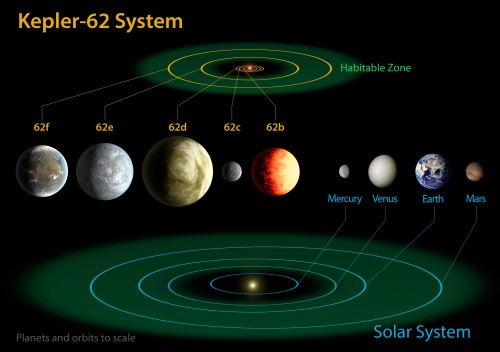Tag archives: life
Extending the ‘Goldilocks’ zone

A comparison of the inner planets of our solar system, within the habitable zone, to Kepler-62 – a five-planet system about 1200 light-years from Earth. (Courtesy: NASA/Ames/JPL-Caltech)
By Ian Randall
In the modish hunt for exoplanets, the holy grail is discovering such a body within the habitable zone of a star – offering a tantalizing potential for extraterrestrial life. If our solar system is anything to go by, we can expect most planets to form outside of the confines of this zone. What if, however, the habitable zone is really larger than we thought?
This is the idea put forward by Sean McMahon from the University of Aberdeen, Scotland, and colleagues in a recent paper – proposing that the existing definition of the habitable zone overlooks the potential for life to survive below the surface of terrestrial planets that currently lie outside the zone’s reach.
View all posts by this author | View this author's profile
Astronomers discover complex organic matter abound in the universe

NASA image of the star field in the constellation Ophiucus; at the centre is the recurrent Nova RS Ophiuci (Credit: John Chumack)
By Tushna Commissariat
Complex organic compounds – one of the main markers of carbon-based life forms – have always been thought to arise from living organisms. But new research by physicists in Hong Kong, published yesterday in the journal Nature, suggests that these compounds can be synthesized in space even when no life forms are present.
Sun Kwok and Yong Zhang at the University of Hong Kong claim that a particular organic compound that is found throughout the universe contains complex compounds that resemble coal and petroleum – which have long been thought to come only from carbonaceous living matter.
The researchers say that the organic substance contains a mixture of aromatic (ring-like) and aliphatic (chain-like) complex components. They have come to this conclusion after looking at strange infrared emissions detected in stars, interstellar space and galaxies that are commonly known as unidentified infrared emissions (UIEs). These UIE signatures are thought to arise from simple organic molecules made of carbon and hydrogen atoms – polycyclic aromatic hydrocarbon (PAH) molecules – being “pumped” by far-ultraviolet photons. But Kwok and Zhang both felt that hypothesis did not fill the bill accurately enough, when they considered the observational data.
As a solution, they have suggested an alternative – that the substances generating these infrared emissions have chemical structures that are much more complex. After analysing the spectra of star dust forming when stars explode, they found that stars are capable of making these complex organic compounds on extremely short timescales of weeks and that they then eject it into the general interstellar space – the region between stars.
Kwok had suggested, at an earlier date, that old stars could be “molecular factories” capable of producing organic compounds. “Our work has shown that stars have no problem making complex organic compounds under near-vacuum conditions,” says Kwok. “Theoretically, this is impossible, but observationally we can see it happening.”
Another interesting fact is that the organic star dust that Kwok and Zhang studied has a remarkable structural similarity to complex organic compounds found in meteorites. As meteorites are remnants of the early solar system, the findings raise the possibility that stars enriched our protoplanetary disc with organic compounds (by angela). The early Earth was known to have been bombarded by many comets and asteroids carrying organic star dust. Whether these organic compounds played any role in the development of life on Earth remains a mystery.
It will also be interesting to see if this finding has an impact on research groups that look for life in the universe, such as SETI , considering that complex organic molecules have always thought to be markers of carbon-based life forms.
View all posts by this author | View this author's profile